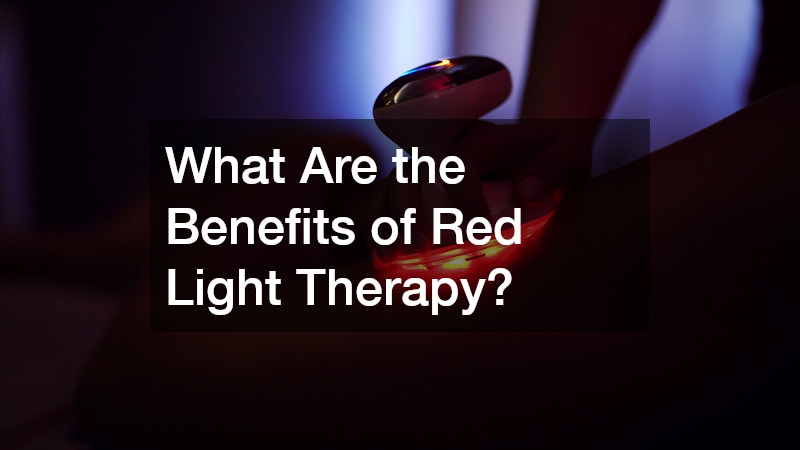Red light therapy is a non-invasive treatment that is gaining popularity for its many health-related applications. By exposing the skin to low levels of red or near-infrared light, this therapy is believed to offer various health benefits.
This article explores the most common questions and topics related to red light therapy to better understand its potential advantages.
How Does Red Light Therapy Work?
The Science Behind Red Light Therapy
Red light therapy affects cellular functions by penetrating the skin and stimulating the mitochondria, which are the powerhouses of cells. This stimulation leads to an increase in adenosine triphosphate (ATP) production, enhancing energy delivery within cells.
The increase in cellular energy prompts improvements in cellular repair and regeneration processes. This mechanism supports the body’s natural healing capabilities, potentially resulting in faster recovery from injuries.
Scientific studies suggest that red light therapy can promote collagen production in the skin. Enhanced collagen production contributes to better skin elasticity and a reduction in fine lines and wrinkles.
Common Devices Used in Red Light Therapy
Various devices are used in red light therapy, ranging from professional equipment to portable at-home devices. Professional devices often deliver higher-intensity light, promising more rapid therapeutic effects.
At-home devices include handheld wands and full-body panels that allow for convenient treatments. Users appreciate the accessibility and affordability of these devices, making red light therapy increasingly popular.
Safety features and specifications vary among different red light therapy devices. Consumers must research and purchase devices that meet safety standards for effective and safe use.
What Are the Skin Benefits of Red Light Therapy?
Improving Skin Texture and Tone
Red light therapy is renowned for its capability to enhance skin texture and tone. It is widely used as a cosmetic treatment to reduce wrinkles and fine lines, offering a non-invasive alternative to surgical procedures.
The therapy encourages collagen synthesis, which is integral to maintaining skin elasticity and hydration. As collagen levels improve, the skin appears firmer and more youthful, with a smoother texture.
Clinically validated results demonstrate significant improvements in skin appearance after consistent red light therapy sessions. Users often notice a visible reduction in signs of aging, making it an appealing skincare routine addition.
Treating Acne and Other Skin Conditions
Red light therapy is also utilized to manage acne, as it reduces inflammation and bacterial growth. Its anti-inflammatory properties make it a suitable adjunct treatment for various skin ailments.
Studies support the efficacy of red light therapy in decreasing acne lesions and accelerating healing. As a non-invasive option, it causes minimal side effects compared to conventional acne medications.
This therapy is gaining attention for its potential to assist in treating rosacea, eczema, and psoriasis. By soothing the skin and enhancing its repair processes, red light therapy offers hope to individuals with chronic skin issues.
Can Red Light Therapy Aid in Pain Relief?
Managing Chronic Pain Conditions
Red light therapy is emerging as a therapeutic option for managing chronic pain conditions, such as arthritis. Its analgesic effects are attributed to reducing inflammation and enhancing blood circulation.
Patients suffering from chronic pain report experiencing relief following regular sessions of red light therapy. These positive outcomes have encouraged further research into its use as an alternative pain management strategy.
By targeting the roots of chronic pain, such as inflammation and cellular damage, red light therapy provides a holistic approach to pain relief. It minimizes reliance on pharmaceuticals and promotes natural healing.
Accelerating Injury Recovery
Athletes and individuals with injuries are turning to red light therapy to expedite the healing process. The therapy decreases recovery time by promoting cellular repair and reducing swelling.
Red light therapy enhances blood flow to the targeted areas, delivering oxygen and nutrients essential for tissue repair. This supports the regeneration of damaged cells and tissues, facilitating quicker recovery.
Studies illustrate that red light therapy might significantly reduce downtime associated with muscle injuries and strains. Incorporating it into rehabilitation programs can be a game-changer for many athletes seeking a fast return to activity.
Is Red Light Therapy Effective for Hair Growth?
The Role of Red Light in Hair Follicle Stimulation
Red light therapy has shown promise in stimulating hair growth through its effects on hair follicles. It enhances blood circulation in the scalp, providing follicles with nutrients that promote hair growth.
Research indicates that red light therapy could prolong the growth phase of hair follicles. This can result in denser and fuller hair over time with consistent treatment sessions.
As a non-invasive method, red light therapy provides an attractive option for individuals experiencing hair thinning. By activating dormant follicles, it offers a potential solution to hair loss.
Clinical Evidence and Consumer Experiences
Clinical studies examining red light therapy for hair growth show promising outcomes. Participants in these studies often report increased hair density and improved scalp health.
Consumer testimonials frequently highlight satisfaction with the visible improvements in hair growth. Many users express a sense of renewed confidence, attributing their success to red light therapy.
While individual results may vary, the growing body of evidence supports the potential of this therapy in combating hair loss. It continues to be studied for optimizing treatment protocols and effectiveness.
Are There Any Side Effects or Risks?
Understanding Potential Side Effects
Red light therapy is generally considered safe, with few reported side effects. Mild reactions, such as temporary redness or dryness, are typically the extent of adverse effects.
Proper use and adherence to recommended guidelines significantly minimize risks associated with red light therapy. Users are advised to follow the manufacturer’s instructions and consult professionals when necessary.
Who Should Avoid Red Light Therapy?
Certain individuals, such as those with photosensitivity or taking light-sensitive medications, should exercise caution with red light therapy. Consulting a healthcare provider is recommended before commencing treatment.
Pregnant women and individuals with specific medical conditions should seek professional advice to assess the suitability of red light therapy. Personalized considerations ensure safe and effective usage.
.







